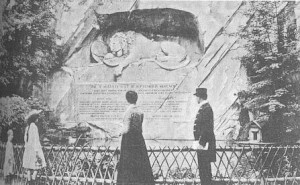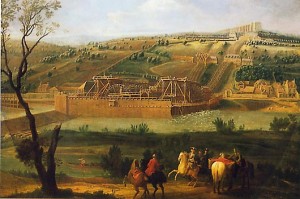5. “The Dying Lion of Lucerne”
This statue commemorates the over 700 Swiss guards who lost their lives defending Marie Antoinette and her husband Louis XVI at the palace of the Tuileries.
4. The poop on… poop at Versailles
Marie Antoinette had a very early version of the flush toilet installed in her suite of rooms! You had to send someone upstairs to open a valve for the flush, though…
There were lots of chamber pots in the place, or course, and plenty of latrines around… but what did many courtiers and visitors end up doing instead of seeking out these facilities? Why, pooping on the stairs, of course. Or in the corners of the Hall of Mirrors, when the darkness fell and they could be assured of some privacy.
Horrifying? Check out Frank Muir’s book “An Irreverent and Almost Complete Social History of the Bathroom.” (Queen Elizabeth I had one of these toilets, too, but hated it – because it was too noisy. )
3. Beauty Marks in a Box
In eighteenth century Europe smallpox raged through the continent, leaving most of its survivors pockmarked in some way. False beauty marks made of velvet, silk, and moleskin were introduced as a way to cover the scars left by smallpox, though they soon blossomed into an independent fashion statement. A variety of shapes were available: hearts, crescent moons, stars and clubs, even a tiny carriage pulled by minuscule silhouette horses!
In France, a patch was known as a “mouche” (fly), and was held on by the application of a flexible and very sticky glue made from the skins of fish. The meaning of the patches’ placement varied by country, and often aesthetics alone won the day – but in France, a patch on the right cheek meant that one was married, one near the mouth meant flirtation, and if the lady next to you wore her heart-shaped patch near her eye – watch out! That was the mark of unbridled passion…
2. Aeronautic History Made at Versailles.
The first successful lighter-than air flight took place at Versailles in 1783! The Montgolfier brothers used hot air from a fire of wool and wet straw to power their balloon, which was made of cotton with azure-blue gilded paper glued on each side.
A sheep, a duck, and a rooster were the passengers placed into the wicker basket beneath the balloon, and then it was released in front of an astonished crowd – and immediately went 1600 feet into the air! Despite a tear in the fabric, the vehicle traveled over a mile before coming down. The animals were placed into King Louis XVI’s menagerie to reward them for their “service.”
1. The Marly Machine
How did they power all of those fountains at Versailles? The fact is, they didn’t. Most of the time, the only fountains that were operating were the ones in sight of the king. Special workmen cleverly closed or opened valves to whatever water features the king might see in a given day. Otherwise, most of them remained dormant!
The “Marly Machine” was constructed to get water to the palace through a long copper aqueduct. The Machine included not just an enormous structure on the river itself, (with fourteen giant paddlewheels) but sprawled all the way up the hill, with pumping stations, holding tanks, reservoirs, pipes and an intricate system of mechanical linkages to power pumps on the hill from the waterwheels below.
Despite the fact that at full capacity, it could put a million gallons a day into the reservoir, the system could never serve all of the fountains at once.









